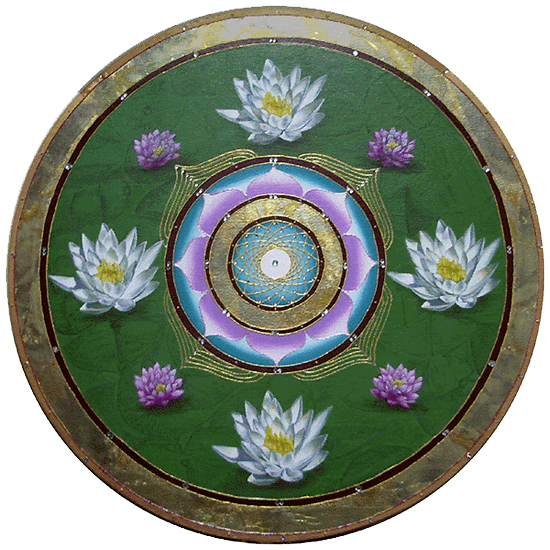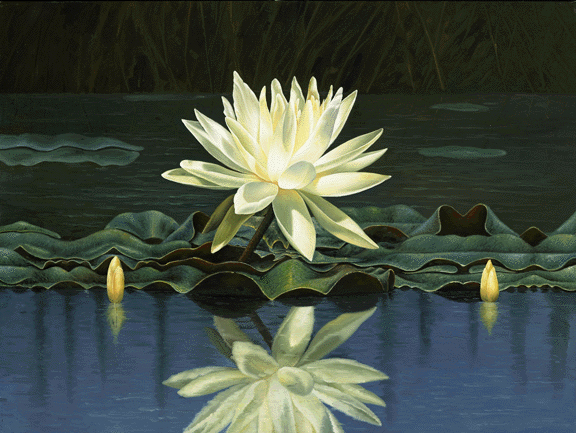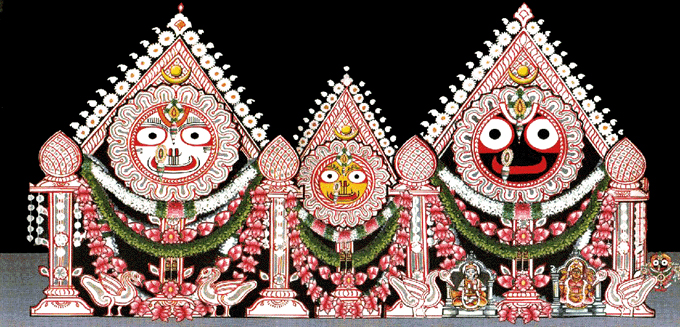
|
|
|
|
BY: SUN STAFF

May 10, 2011 — CANADA (SUN) — A study of the historical, spiritual and cultural elements of Vedic design. Today we begin a new study in the Design Motifs series, this time honoring one of India's most familiar sacred symbols – the lotus. Since ancient times, this simple, elegant motif has inspired an amazing range of spiritual allegory, and artistic representations of it are embedded in India's cultural history, and in religious traditions worldwide. Since we again find ourselves in the months leading up to Lord Jagannath's Ratha Yatra in Puri Dham, we will begin our study of the lotus there. The lotus plays an integral part in Jagannath worship year round, but it is especially featured at certain times of the year, most importantly, in May/June on Jyestha Purnima, the birthday of Lord Jagannatha. A grand Snana Yatra is performed on that day, and many rituals performed. This year, Jyestha Purnima will be held on June 15th. On that day, Lord Jagannath, Baladev and Subhadra are brought in a colorful pahandi procession to the richly decorated snana bedi bathing platform in the Ananda Bazar. Here, they take sacred bath. Sudarshan and Madanmohan also join them. 108 pitchers full of scented water are drawn from the Suna kua, a holy well near the north gate. Water is poured over the Deities amidst chanting of mantras and loud rejoicings. Soon after their bath, Lord Jagannath appears in the form of Ganesha, while Subhadra appears in the form of Padma Vesha, the Lord's vesha (outfit) adorned with lotuses. This particular vesha is also called Gaja Vesha.

Another of the most popular rituals at Puri temple which feature the lotus is the Padma Vesha performed on the 11th bright day of the month Magha (Jan-Feb). This Padma Vesha has been going on at Srimandir for the last three hundred years. Lord Jagannath is worshipped as the brightness of the lotus in all hearts, and He is called Padma Lochana (Lotus Eye God). At the present time, the Padma Vesha materials are supplied to Lord Jagannath by the Badachata Matha. Skilled artists prepare the lotus flower buds with sola sraft, silver and golden threads, plant threads, cotton cloth, gum of wood apple and various colors. Three masks are made with lotus flowers, and petals of cotton and hair are affixed to the masks. This particular Padma Vesha is offered at bada singhar, the Deities' bedtime. This is the only day of the year when the Deities go to sleep with Padma Vesha on, and it marks the beginning of spring, when Lotus flowers are very abundant. Padma Vesha is celebrated on Tuesdays and Saturdays from the new moon of Magha to Basanta Panchami.

Lord Jagannath's Padma Vesha Following are extracts of an article about the culture of lotuses in Jagannath worship, excerpted from a piece by Jayanti Rath of Bhubaneswar, Orissa. Padma Vesha Patta of the Jagannatha Deities A full blown lotus is the symbol of the universe in which the divinity is established. It is the symbol of awakening of the spirit and the flowering of the psyche. It is held sacred by the Hindus who have installed all their principal Gods and Goddesses on Padmasana (lotus-seat). In other words, nothing can be conceived without Padma in religion and that is equally true in the sphere of art, sculpture and painting. The Supreme Lord Visnu is closely associated with padma. Padma is one among His four ayudhas, or pieces of paraphernalia, the other three being sankha (conch), chakra (Disc) and gada (mace). His feet are called Lotus-feet, hands are lotus-hands, eyes are lotus-eyes. Similarly His consort, Goddess Lakshmi, is called Padmakshi (lotus-eyed), and Padma Sambhava (originated from lotus). It goes without saying that in the rituals of the temple of Lord Jagannath, who is unequivocally the incarnation of Sri Krsna, padma is given prime importance. So among the various veshas of the Triad, one is specifically related with padma, and that is called Padma Vesha. The Padma Vesha is at once very attractive and symbolic. Traditionally, from the Sukla Sasthi of Margasira month till the Basanta Panchami, the three Vigrahas are covered with winter wrappers at night. This ritual is called ghoda lagi, and it is observed to protect the Deities from excessive cold. On Wednesday, the colour of the wrapper is green and on Saturday it is black. The Padma Vesa is put on over this wrapper. It is made during the Bada Sinhara, and the Deities remain with the vesha throughout the night. Big petals of lotus adorn the faces of the Deities, in the shape of a disc. Lord Balabhadra and Lord Jagannath hold lotus buds in Their hands. Three triangular crowns made of crape and cloth are decorated with innumerable lotus flowers. Now-a-days, artificial flowers are sometimes used instead of natural flowers. It is interesting to note that four swans are also projected in this Vesha. They are seen with the lotus stalks, which makes the vesha appear very lively. There is an interesting episode related to this Vesa. As the story goes, long long ago there was a devotee named Manohar Das living in village Shahpur on the bank of the sacred river Rishikulya. With a strong desire to have darshan of the Lords, Manohar started his journey by walking from the distant village to Puri. He brought with him a basket full of lotus flowers. Over the course of his long journey he came across a number of tanks. At every tank he put some new flowers in the basket and poured water on the old ones to make them fresh. At last he reached Puri and halted at Bada Chhata Matha, just adjacent to the Sri Mandira boundary (Purba dwar). The trouble of the long painful journey could not deter him. The very thought that he would offer the flowers to the Lord enlivened his spirit. With that simple faith and devotion he entered inside the temple. The Sevakas saw the pitiable condition of the old man. They asked him about the thing he kept in the basket covering a towel. He showed them the flowers, which were stale and stinking by that time. The Sevakas threw the rotten flowers in the kitchen drain of the temple and beat him cruelly for his madness. Due to severe injury and mental shock, Manohar Das fell on the ground and became unconscious. In the night, the dwellers of Bada Chhata Matha brought him back and put him to rest. Lord Jagannath appeared in the dream of the king that night, asking him to go immediately to Manohar and consider the matter with all kindness. The king called the Rajguru and explained the theme of the dream. The Rajguru took Manohar inside the temple, where with much care they collected the thrown away flowers, and adorned the Deities with those flowers to fulfill the wish of Manohar. Surprisingly, the flowers looked bright pink and emanated divine and sweet fragrance. The blessing of the Lord on Bhakta Manohar could be heard from the void. The Chitrakar (temple painter) finds immense pleasure in depicting this Vesha. Usually he draws full blown lotus, eight-petalled lotus and the lotus buds as the border designs in Vaishnava pattas. In the making of Padma Vesha Patta, the lotus is taken not only as a decorative programme, it becomes the sole theme. References:
1. J.P. Das - Puri Paintings
| |